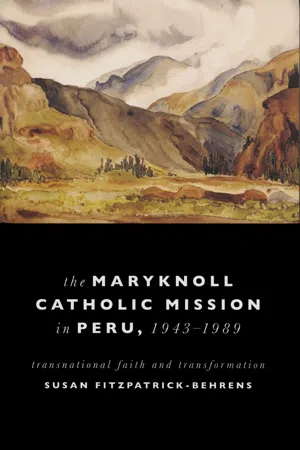
Kellogg Institute Series on Democracy and Development
Transnational Faith and Transformations
- 328 pages
- English
- PDF
- Available on iOS & Android
Kellogg Institute Series on Democracy and Development
Transnational Faith and Transformations
About This Book
Maryknoll Catholic missionaries from the United States settled in Peru in 1943 believing they could save a "backward" Catholic Church from poverty, a scarcity of clergy, and the threat of communism. Instead, the missionaries found themselves transformed: within twenty-five years, they had become vocal critics of United States foreign policy and key supporters of liberation theology, the preferential option for the poor, and intercultural Catholicism.
In The Maryknoll Catholic Mission in Peru, 1943-1989, Susan Fitzpatrick-Behrens explains this transformation and Maryknoll's influence in Peru and the United States by placing it in the context of a transnational encounter Catholics with shared faith but distinct practices and beliefs. Peru received among the greatest number of foreign Catholic missionaries who settled in Latin America during the Cold War. It was at the heart of liberation theology and progressive Catholicism, the center of a radical reformist experiment initiated by a progressive military dictatorship, and the site of a devastating civil war promoted by the Maoist Shining Path. Maryknoll participated in all these developments, making Peru a perfect site for understanding Catholic missions, the role of religion in the modern world, and relations between Latin America and the United States.
This book is based on two years of research conducted in Peru, where Fitzpatrick-Behrens examined national and regional archives, conducted extensive interviews with Maryknoll clergy who continued to work in the country, and engaged in participant observation in the Aymara indigenous community of Cutini Capilla. Her findings contest assumptions about secularization and the decline of public religion by demonstrating that religion continues to play a key role in social, political, and economic development.
Frequently asked questions
Information
Table of contents
- Cover
- Half title
- Series page
- Title page
- Copyright
- CONTENTS
- ACKNOWLEDGMENTS
- Introduction
- 1. Maryknoll and the New Deal for Latin America
- 2. First Impressions
- 3. The Transformative Power of Tradition, 1954– 1967
- 4. The Limits of Alliances, 1968–1976
- 5. Reform, Violence, and “Reconciliation,” 1976–1989
- Epilogue
- APPENDIX
- NOTES
- SELECTED BIBLIOGRAPHY
- INDEX